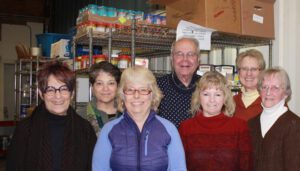
The Woodstock Community Food Shelf board of directors: back row, left to right: Sally Gottlieb, Joan Williamson, Norm Youknot and Laura Kent; front row: Cassie Horner, Sheila Murray and Bev Regan.
Food shelves provide support for a community and can also inspire the community itself. Like many Vermonters, I grew up in poverty. Our local food shelf provided essential and timely support keeping food on our table and connecting us with other community resources. Since it was the ‘80s, light years before the Internet access became wide-spread, my family learned of the aid available by seeing collection boxes at the local supermarket. Once we were no longer in need, we donated food to those very same boxes. We also told as many people as possible about this important resource.
Now, twenty five years later, I am visiting several Vermont food shelves, this time to provide digital advising on behalf of the Vermont Digital Economy Project. What I discovered is that many local, volunteer food shelves, like so many other community institutions, appear to have been passed over by the digital revolution. They had rightly focused their energies on their core mission and relied on traditional methods to spread the word. Simply put, the limited resources they had available were used to help feed their community.
Knowing that we could make a difference, our project decided to help several food shelves move into the digital age through a combination of advising, free webhosting, and assistance from the tech community. Through a collaborative process with local volunteers, we brainstormed what tools could make them more efficient, resilient, and effective. This led to a focus on making food shelves more visible within their communities, promoting additional ways for people to donate both food and money to the foodshelf, and making it easier for those in need to find the foodshelf.
I recently checked in with a few of these organizations to see how things were progressing. What I found furthered my appreciation of digital tools as a means to building community support networks. Donations are coming in through the upgraded websites, new people are becoming involved after learning about the organizations online, and the foodshelves are using social media to connect with others and to share ideas and best practices with peer organizations and with the larger community.
The Bethel Food Shelf served hot meals for several weeks after Tropical Storm Irene and continues to be an important resource for the community. When I first met with them they didn’t have a website or social media presence. In just one month we coordinated efforts between food shelf volunteers and the tech community to set the Bethel Food Shelf up with a basic WordPress website and get them started on social media. Since the initial launch, they have focused on developing a strategy for using these tools.
Kathy Hartman has taken on the task of developing the social media strategy. “Having a social media presence is important both in creating a presence for those who need our assistance and for those who support the food shelf. The young people of our community are amazing with their food drives and their volunteer efforts at the food shelf. We envision social media as a way to further engage them in the work of the organization.”
The value of social media and a web presence was also appreciated by the Woodstock Community Food Shelf. According to Cassie Horner, a volunteer with the food shelf, “The website and especially Facebook are in great use for us. We have been getting some donations through the website and the response to the Woodstock Community Food Shelf Facebook page is growing. I would say Facebook and the website have quickly become an important way we are communicating with people about the food shelf, getting the word out, and showing the community how active we are as an organization helping people who need food.”
Sandy Vincent of the Chester-Andover Family Center, an organization that manages both a food shelf and a thrift shop, manages their growing Facebook Page. According to Sandy, she uses Facebook to post “specials, recipes, closings, reminders, information, thank you’s and photos.” She also appreciates being able to go to other food shelf pages to check in to see what they are doing. For her, it’s a way of connecting to others doing similar work and finding inspiration and support when needed. “It’s a nice way to get a quick pulse of what’s happening and to see photos that tell our story.”
Digital tools are complementary to and not a substitute for the innumerable hours that hundreds of Vermonters donate to their community food shelf each month. These tools are an extremely valuable way, when used effectively, to extend the mission. If you know of a food shelf in your community that could benefit from some coaching about the use of online tools, please take a moment to share the information about how we can help. While you’re at, please also consider volunteering a few hours of your time.
